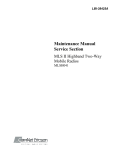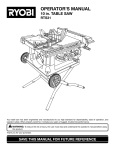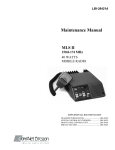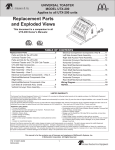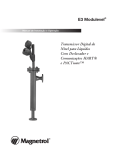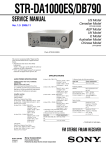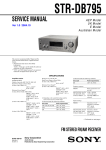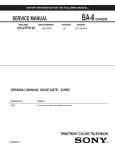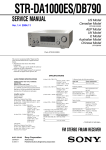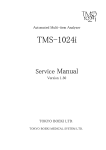Download MLS MLSH041 Installation manual
Transcript
LBI-38438A Maintenance Manual Service Section MLS High-Band Two-Way Mobile Radios MLSH041 GENERAL INFORMATION NOTICE! Repairs to this equipment should be made only by an authorized service technician or facility designated by the supplier. Any repairs, alterations or substitution of recommended parts made by the user to this equipment not approved by the manufacturer could void the user's authority to operate the equipment in addition to the manufacturer's warranty. NOTICE! The software contained in this device is copyrighted by Com-Net Ericsson Critical Radio Systems, Inc. Unpublished rights are reserved under the copyright laws of the United States. This manual is published by Com-Net Ericsson Critical Radio Systems, Inc., without any warranty. Improvements and changes to this manual necessitated by typographical errors, inaccuracies of current information, or improvements to programs and/or equipment, may be made by Com-Net Ericsson Critical Radio Systems, Inc., at any time and without notice. Such changes will be incorporated into new editions of this manual. No part of this manual may be reproduced or transmitted in any form or by any means, electronic or mechanical, including photocopying and recording, for any purpose, without the express written permission of Com-Net Ericsson Critical Radio Systems, Inc. . Copyright © 1990-2000, Com-Net Ericsson Critical Radio Systems, Inc. All rights reserved. 2 LBI-38438A TABLE OF CONTENTS 1 DESCRIPTION ........................................................................................................................................4 2 INITIAL ADJUSTMENT........................................................................................................................4 2.1 TRANSMITTER ADJUSTMENT...............................................................................................4 2.2 RECEIVER ADJUSTMENT .......................................................................................................4 2.3 RE-INSTALLATION ..................................................................................................................4 3 MAINTENANCE .....................................................................................................................................5 3.1 PREVENTIVE MAINTENANCE...............................................................................................5 3.1.1 Connections ...................................................................................................................5 3.1.2 Electrical System ...........................................................................................................5 3.1.3 Mechanical Inspection ...................................................................................................5 3.1.4 Antenna..........................................................................................................................5 3.1.5 Alignment ......................................................................................................................5 3.1.6 Frequency Check ...........................................................................................................5 3.1.7 Disassembly...................................................................................................................5 3.2 PA TRANSISTOR REPLACEMENT .........................................................................................6 3.3 CHIP COMPONENT REPLACEMENT.....................................................................................7 3.3.1 To Remove Chip Components.......................................................................................7 3.3.2 To Replace Chip Components .......................................................................................7 4 DISASSEMBLY PROCEDURE .............................................................................................................8 4.1 TO REMOVE THE SYSTEM CONTROL/SYNTHESIZER BOARD.......................................8 4.2 TO REMOVE THE TRANSMITTER RECEIVER BOARD......................................................8 4.3 TO REMOVE THE FRONT PANEL/CONTROL UNIT............................................................8 5 ALIGNMENT AND TROUBLESHOOTING PROCEDURES...........................................................11 5.1 SYNTHESIZER...........................................................................................................................11 5.1.1 Test Equipment Required ..............................................................................................11 5.1.2 TX VCO & RX VCO Alignment...................................................................................12 5.1.3 Transmitter Frequency Adjustment ...............................................................................13 5.1.4 Receiver Frequency Adjustment....................................................................................13 5.1.5 Modulation Level Adjustment .......................................................................................13 5.1.6 Audio Check ..................................................................................................................14 5.1.7 Audio Output Level Adjustment Procedure...................................................................15 5.2 TRANSMITTER..........................................................................................................................16 5.2.1 General Description of Adjustment ...............................................................................16 5.2.2 Measuring Instruments ..................................................................................................16 5.2.3 Adjustment System ........................................................................................................17 5.2.4 Transmitter Adjustment Procedure ................................................................................17 5.3 RECEIVER ..................................................................................................................................20 5.3.1 Receiver Alignment .......................................................................................................20 5.3.2 Alignment Procedure .....................................................................................................21 5.3.3 Fixed Squelch Adjustment.............................................................................................21 5.3.4 Receiver Test Procedures...............................................................................................22 5.3.5 Test Procedure ...............................................................................................................22 LBI-38438A 3 DESCRIPTION 1 DESCRIPTION The service section contains the information necessary for aligning and troubleshooting the MLS two-way FM mobile radio. In addition, information is provided for removing and replacing chip components, disassembly procedures and module replacement procedures. 2 INITIAL ADJUSTMENT After the radio has been installed as described in the Installation Manual, the following adjustments should be made by a certified electronics technician. 2.1 TRANSMITTER ADJUSTMENT The transmitter has been adjusted at the factory and should require no readjustment. However, the antenna length should be adjusted for optimum VSWR, and the frequency and modulation measured and recorded for future reference. For the complete transmitter adjustment, refer to the Alignment Procedure (see Table of Contents). 2.2 RECEIVER ADJUSTMENT No initial adjustments to the receiver are required. Refer to the Table of Contents for the complete receiver alignment. 2.3 RE-INSTALLATION The MLS series mobile radios are designed to operate in 12-Volt, negative ground vehicles only. If the mobile radio is moved to a different vehicle, always check the battery polarity of the new vehicle system. 4 LBI-38438A MAINTENANCE 3 MAINTENANCE 3.1 PREVENTIVE MAINTENANCE To insure high operating efficiency and to prevent mechanical and electrical failures from interrupting system operations, routine checks should be made of all mechanical and electrical parts at regular intervals. Preventive maintenance should include checks detailed in the following sections. 3.1.1 Connections Ground connections to the voltage source should be periodically checked for tightness. Loose or poor connections to the power source will cause excessive voltage drops and faulty operation. When ground connections are not made directly to the battery, the connection from the battery to vehicle chassis must be checked for low impedance. A high impedance may cause excessive voltage drops and alternator noise problems. 3.1.2 Electrical System Check the voltage regulator and alternator or generator periodically to keep the electrical system within safe and economical operating limits. Over-voltage is indicated when the battery loses water rapidly. Usage of 1 or 2 ounces of water per cell per week is acceptable for batteries in continuous operation. A weak battery will often cause excessive noise or faulty operation. 3.1.3 Mechanical Inspection Since mobile units are subject to constant shock and vibration, check for loose plugs, nuts, screws and parts to make sure that nothing is working loose. 3.1.4 Antenna The antenna, antenna base and all contacts should be kept clean and free from dirt or corrosion. If the antenna or its base should become coated or poorly grounded, loss of radiation and a weak signal will result. 3.1.5 Alignment The transmitter and receiver meter readings should be checked periodically, and the alignment “touched up” when necessary. Refer to applicable Alignment Procedure and Troubleshooting sheet for typical voltage readings. 3.1.6 Frequency Check Check transmitter frequency and deviation. Normally, these checks are made when the unit is first put into operation, after the first six months and once a year thereafter. 3.1.7 Disassembly To gain access to the transmitter, receiver, and the system control/synthesizer boards for servicing, loosen the four screws securing the cover at the rear of the radio. Then pull the cover out from under the edge of the front panel and lift the cover off. LBI-38438A 5 MAINTENANCE The PA transistor contains Beryllium Oxide, a TOXIC substance. If the ceramic or other encapsulation is opened, crushed, broken or abraded, the escaping dust may be hazardous if inhaled. Use care when replacing the module. WARNING 3.2 PA TRANSISTOR REPLACEMENT 1. Remove the two retaining screws securing PA transistors TR3 and TR4 to chassis assembly. 2. Unsolder and remove capacitors. Use a de-soldering tool as necessary while lifting the transistor leads with a small screwdriver or pick. Discard old capacitors. 3. Unsolder the emitter, base and collector leads of the transistor, and remove it from the printed board. 4. Remove all excess solder from the board, and clean the holes to allow the new transistor to be positioned properly and the capacitors to fit into proper locations. Refer to Figure 1 and trim the new transistor leads (if required) to the lead length of the removed transistor. 5. Apply silicon grease to back of the replacement transistor and place the transistor into the mounting slot. 6. Replace the transistor mounting screws using a moderate torque of 5 inch-pounds. 7. Tack solder the four base leads to the printed board using minimum solder. Then solder the emitter and collector leads. 8. Install the capacitors into their proper mounting areas, flush to the board. 9. Solder the capacitor bodies to the printed board by first soldering the outside edge. Then, holding the iron to the outside edge, touch the solder to the inside edge of the capacitor. Be careful not to create solder bridges at the front and back edges of the capacitors. 10. Remove any flux left on board. Figure 1- PA Transistor Lead Identification 6 LBI-38438A MAINTENANCE 3.3 CHIP COMPONENT REPLACEMENT Replacement of chip capacitors should always be done with a temperature controlled soldering iron, using a controlled temperature of 700ºF (371º C). However, do NOT touch black metal film of the resistors or the ceramic body of capacitors with the soldering iron. The metallized end terminations of the parts may be touched with the soldering iron without causing damage. NOTE 3.3.1 To Remove Chip Components 1. Using two soldering irons, heat each end of the chip at the same time until solder flows, and then remove and discard the chip. 2. Remove excess solder with a vacuum solder extractor. 3. Carefully remove the epoxy adhesive and excess flux to prevent damage to the printed board. 3.3.2 To Replace Chip Components 1. Using as little solder as possible, “tin” one end of the component and one of the pads on the printed wiring board. 2. Place the “tinned” end of the component on the “tinned” pad on the board and simultaneously touch the component and the pad with a well “tinned” soldering iron while pressing the component down on the board. 3. Place the “tinned” soldering iron on the other end of the component and the pad simultaneously. Apply solder to the top of the end of the component until the solder starts to flow. Use as little solder as possible while getting a good joint. 4. After the component has cooled, remove all flux from the component and printed wiring board area with alcohol. The CMOS integrated circuit devices used in this equipment can be destroyed by static discharges. Before handling of one of these devices, the serviceman should discharge himself by touching the case of a bench test instrument that has a 3-prong power cord connected to an outlet with a known good earth ground. When soldering or desoldering a CMOS device, the soldering iron should also have a 3-prong power cord connected to an outlet with a known good earth ground. A battery-operated soldering iron may be used in place of the regular soldering iron. LBI-38438A 7 DISASSEMBLY PROCEDURE 4 DISASSEMBLY PROCEDURE 4.1 TO REMOVE THE SYSTEM CONTROL/SYNTHESIZER BOARD 1. Remove the two (2) screws (A) securing the top cover (refer to Figure 2). Remove the top cover. Then disconnect the interconnecting cables. 2. Remove the eight (8) screws (B) securing the Synthesizer shield. Remove the shield. 3. Remove the three (3) screws (D) securing the board. 4. Remove the screws (C) securing regulator and carefully lift up and remove the board. 4.2 TO REMOVE THE TRANSMITTER RECEIVER BOARD 1. Remove the screws (E) securing the bottom cover (refer to Figure 3). 2. Disconnect the interconnecting cable. Remove the seven (7) screws (G), (H) securing the receiver shield and the antenna shield. 3. Remove the two (2) screws (F) connecting the power supply cable to the board and turn the cable stopper mounted on the rear of the frame assembly 90 degrees. Lift the cable stopper up and remove the power supply cable. 4. Remove the two (2) screws (I) securing power module HC1. Remove the (I) screws securing the power transistors, audio IC, and AVR IC. 5. Remove the two (2) screws (J) securing the board. Carefully lift up and remove the board. 4.3 TO REMOVE THE FRONT PANEL/CONTROL UNIT 1. Remove the four (4) screws (N) securing the front panel to the frame assembly (refer to Figure 4). 2. Carefully disconnect the speaker cable from the connector on the Control/Synthesizer board. 3. Separate the front panel from the frame assembly. 4. Carefully disconnect the ribbon cable connecting the Front Panel/Control unit to the Control/Synthesizer Board at (O). 5. Remove the two (2) screws located at (P). 6. While pushing the lock tabs at (Q) remove the Control Panel towards the front. 8 LBI-38438A DISASSEMBLY PROCEDURES Figure 2 – Disassembly Procedure (Top View) Figure 3 – Disassembly Procedure (Bottom View) LBI-38438A 9 DISASSEMBLY PROCEDURE Figure 4 – Disassembly Procedure (Front Panel) 10 LBI-38438A ALIGNMENT AND TROUBLESHOOTING PROCEDURES 5 ALIGNMENT AND TROUBLESHOOTING PROCEDURES Radio maintenance is facilitated by using the Troubleshooting Procedures and servicing techniques unique to this radio. The Troubleshooting Procedures are designed to lead the serviceman rapidly to the defective component or circuit. Troubleshooting procedures are provided for most major problems that might arise in the Transmitter, the Receiver, and the System Control/Synthesizer Board. 5.1 SYNTHESIZER Alignment and Troubleshooting for Synthesizer Circuitry on System Control/Synthesizer Board CMC-551A/B are detailed in the following subsections. 5.1.1 Test Equipment Required 1. Audio Oscillator 2. Deviation Monitor 3. Oscilloscope 4. Frequency Counter 5. RF Wattmeter (50 ohms, 100 W) 6. VTVM 7. Digital Voltmeter 8. Power Supply, 13.6 VDC regulated. LBI-38438A 11 ALIGNMENT AND TROUBLESHOOTING PROCEDURES 5.1.2 TX VCO & RX VCO Alignment CMC-232A 29.7 - 42 MHz STEP 1 METERING POINT TP201 Control Voltage Monitor TUNING CONTROL L206 METER READING PROCEDURE 4.0 VDC In case highest transmit frequency is < 34.0 MHz. Select lowest frequency transmit channel. With 50 ohm load on the antenna connector J1, key the radio. Monitor TP201 with digital voltmeter and tune L206 for 4.0 VDC ±0.1 V. Unkey the radio. 7.0 VDC 2 TP201 CV201 7.0 VDC 3 TP201 3.5-7.5 VDC 4 J201 +1 to +8 dBm In case the highest transmit frequency is > 34.0 MHz. Select highest frequency transmit channel. With 50 ohm load on the antenna connector J1, key the radio. Monitor TP201 with a digital voltmeter and tune L206 for 7.0 VDC ±0.1 V. Unkey the radio. Select the highest frequency receive channel. Monitor TP201 with digital voltmeter and tune CV201 for 7.0 VDC ±0.1 V. Select lowest frequency channel. Voltage should be between 3.5 – 7.5 VDC transmit and receive for lowest and highest frequency channels. RX/EX injection level should be between +1 and +8 dBm. NOTE: Refer to Figure 5 for location of tuning and adjustment controls. Figure 5 – Synthesizer Tuning and Adjustment Controls CMC-232B 42 – 50 MHz 12 LBI-38438A ALIGNMENT AND TROUBLESHOOTING PROCEDURES METERING POINT TP201 Control Voltage Monitor TUNING CONTROL L206 METER READING 7.0 VDC 2 TP201 CV201 7.0 VDC 3 TP201 3.5-7.5 VDC 4 J201 +1 to +8 dBm STEP 1 5.1.3 PROCEDURE Select highest frequency transmit channel. With 50 ohm load on the antenna connector J1, key the radio. Monitor TP201 with digital voltmeter and tune L206 for 7.0 VDC ±0.1 V. Unkey the radio. Select the highest frequency receive channel. Monitor TP201 with digital voltmeter and tune CV201 for 7.0 VDC ±0.1 V. Select lowest frequency channel. Voltage should be between 3.5 – 7.5 VDC transmit and receive for lowest and highest frequency channels. RX/EX injection level should be between +1 and +8 dBm. Transmitter Frequency Adjustment STEP METERING POINT TUNING CONTROL METER READING 1 J201 (or J1) FREQ TRIM Control on TCXO (XU201) Channel Operating Frequency PROCEDURE NOTE This step assumes the frequency is measured when the transmitter is first keyed. If delayed, the rapidly rising ambient temperature must be taken into consideration. The oscillator frequency should be set at 25°C ambient temperature. Press the PTT switch while monitoring RX/EX injection frequency at J201. Adjust FREQ TRIM Control on TCXO (XU201) for the assigned channel frequency ±0.5 PPM. 5.1.4 Receiver Frequency Adjustment No receiver frequency adjustment is required. With proper alignment of EX injection frequency, RX injection frequency will automatically be correct. 5.1.5 Modulation Level Adjustment Procedure for synthesizer Transmit Deviation 1. Select the highest frequency channel. 2. Rotate CG DEV ADJUST, RV202 fully counterclockwise. LBI-38438A 13 ALIGNMENT AND TROUBLESHOOTING PROCEDURES 3. Connect the audio oscillator and apply a 1 kHz tone at 850 mVrms to MIC HI, J7014. Connect the deviation monitor to the antenna connector, J1 through a 30 dB decoupler. Key the radio. Set DEV ADJUST, RV201 for ±3.75 kHz deviation. 4. Set RV202 fully clockwise. Remove P602 from position 1-2 and set aside. Apply a 400 Hz tone to J602-2 and with the radio keyed, vary its amplitude until the Deviation Monitor reads 2 kHz. Note the level. 5. Change the audio oscillator frequency for a 10 Hz tone at the same level and set LOOP MOD ADJUST RV203 for a deviation of 2 kHz. Unkey the radio. 6. Disconnect the audio oscillator and replace P602 in position 1-2. 7. Select a frequency with Tone Channel Guard. 8. Key the radio and set CG DEVIATION ADJUST RV202 for a deviation reading of ±0.75 kHz. If Channel Guard is not used on any frequency channel, CG DEV ADJUST, RV201 may be set for ± 4.5 kHz deviation instead of ±3.75 kHz. NOTE 5.1.6 Audio Check 5.1.6.1 Audio Sensitivity 1. Connect audio oscillator output to MIC HI, J701-4. Adjust output for 1 kHz at 1 Vrms. 2. Reduce oscillator output until deviation monitor indication falls to ±3.0 kHz for radios without Channel Guard or to ±2.25 kHz for radios with Channel Guard. Oscillator output voltage should be less than 120 millivolts. . 14 LBI-38438A ALIGNMENT AND TROUBLESHOOTING PROCEDURES 5.1.7 Audio Output Level Adjustment Procedure STEP METERING POINT TUNING CONTROL METER READING 1 J701-1 RV601 See Procedure PROCEDURE Set the signal generator to the receiver frequency with ±3 kHz deviation and 1 kHz modulation. Set the RF signal level to 1000 microvolts. Move P551 from J551-1, 2 to J5512, 3 on the Transmitter/Receiver Board. Connect RF signal generator to J1. Terminate J701-1, 6 with a 4 ohm, 6-watt resistor, connect the audio level meter and the distortion analyzer input across the resistor. Set the volume to the maximum point. Press DOWN button two times. Adjust RV601 for 4-watt output (4 Vrms, using the distortion analyzer as Volt Meter). Return P551 to J551-1, 2. Control Logic Troubleshooting LBI-38438A 15 ALIGNMENT AND TROUBLESHOOTING PROCEDURES 5.2 TRANSMITTER Alignment and troubleshooting for Transmitter circuitry on the Transmitter/Receiver board CMN-233A/B. 5.2.1 General Description Of Adjustment This manual is prepared for adjustments and confirmations of the Exciter/PA section and covers the following items. 5.2.2 Measuring Instruments 1. AVR (DC Power Supply DC 0-20V, 20A) 2. Power Meter (usable at the value above 80 W) 3. Directional Coupler 4. Signal Generator 5. Spectrum Analyzer 6. Attenuator (30 dB, above 80 W) 7. Tester 16 LBI-38438A ALIGNMENT AND TROUBLESHOOTING PROCEDURES 5.2.3 Adjustment System 5.2.4 Transmitter Adjustment Procedure STEP 1 ITEM Initial Setting 2 Confirming the voltage TEST POINT TUNING CONTROL TP4 3 Setting APC off power RV1 RV2 4 5 LBI-38438A Confirming minimum power Confirming APC on power RV1 RV1 PROCEDURE Turn the volume on APC RV1, RV2 fully counterclockwise (CCW). Disconnect RF cable P101 from connector J201. Turn on the power. Turn on the PTT (ground J701-2). Confirm voltage of TR8 collector is 9V at TP4 and that the relay K1 clicks at this time. Connect RF cable P101 to J201. Turn the control RV1 on APC fully clockwise (CW). Next, turn the volume RV2 slowly CW and set an output of 70W ±2W at the highest frequency of each band. Turn the volume RV1 on APC fully CCW and confirm minimum power of 30W or less. Turn volume RV1 on APC slowly CW and set an output of 64W ±2W at the highest frequency of each band. 60W or more for other frequencies. 17 ALIGNMENT AND TROUBLESHOOTING PROCEDURES 5.2.5 18 Transmitter Troubleshooting LBI-38438A ALIGNMENT AND TROUBLESHOOTING PROCEDURES LBI-38438A 19 ALIGNMENT AND TROUBLESHOOTING PROCEDURES 5.3 RECEIVER Alignment and Troubleshooting for Receiver Circuitry on Transmitter/Receiver Board CMN-233A/B. 5.3.1 Receiver Alignment 5.3.1.1 Equipment Required 1. RF Signal Generator (29 - 50 MHz) 2. DC Voltmeter 3. Frequency Counter (up to 100 MHz with 0.05 V sensitivity) 4. Audio Level Meter and Distortion Analyzer 5. 4 ohm, 6 Watt Resistor 5.3.1.2 Preliminary Adjustment 1. Connect 13.8 VDC to P2 2. Set MONITOR switch to “out” position 3. Select desired channel 4. Disable Channel Guard by connecting ground to J701-7 5. Connect RF Signal Generator to antenna jack J1 Make sure the transmitter is properly aligned before aligning the receiver. NOTE 20 LBI-38438A ALIGNMENT AND TROUBLESHOOTING PROCEDURES 5.3.2 Alignment Procedure STEP 1 TEST POINT TP501 TUNING CONTROL 2 TP503 L513 METER READING PROCEDURE 9.0 ± 0.2 Connect the DC Voltmeter to TP501. VDC See Set the signal generator on the Procedure receive frequency with ±3 kHz deviation and 1 kHz modulation. Set the RF signal level to 1000 microvolts. Connect the audio level meter (use a high impedance meter) to TP503. 5 J701-1 -6 See Procedure Adjust the L513 until audio output level becomes maximum. Move P551 from J551-1 & 2 to J551-2 & 3 in receiver unit. Terminate J701-1 & -6 with a 4 ohm, 6 watt resistor. Connect the Audio Level Meter and Distortion Analyzer input across the resistor. 4 J701-1 -6 L503 L505 L510 See Procedure Adjust the volume control for 4 W output (4.0 Vrms) using Audio Level Meter. Set the output signal level of RF signal generator so as to obtain 12 dB SINAD at audio output. Adjust coils L503, L505 and L510 to obtain maximum 12 dB SINAD sensitivity. Return P551 to J551-1, 2. 5.3.3 Fixed Squelch Adjustment 1. Disable Channel Guard, if present, (ground J701-7). Set squelch control RV531 full CCW. 2. Connect a signal generator to antenna jack J1 and adjust for nominal 8 dB SINAD signal. 3. Adjust squelch control RV531 to maximum squelch. Receiver must be muted. 4. Adjust squelch control RV531 slowly until receiver unmutes. LBI-38438A 21 ALIGNMENT AND TROUBLESHOOTING PROCEDURES 5. Check that the squelch opens at an input signal level corresponding to 8 dB SINAD (±1 dB). 6. Remove ground from J701-7 or re-enable Channel Guard. 5.3.4 Receiver Test Procedures These Test Procedures are designed to help you service a receiver that is operating, but not properly. The problems encountered could be low power, poor sensitivity, distortion, and low gain. By following the sequence of test steps starting with Step 1, the defect can be quickly localized. Once the defective stage is pin-pointed, refer to the “Service Check” listed to correct the problem. Additional corrective measures are included in the Troubleshooting Procedures. Before starting with the Receiver Test Procedures, be sure the receiver is tuned and aligned to the proper operating frequency and the transmitter is operating properly. 5.3.4.1 5.3.5 TEST EQUIPMENT REQUIRED 1. Distortion Analyzer 2. Signal Generator 3. 6 dB Attenuation Pad, and 4.0 ohm, 6 Watt Resistor Test Procedure 5.3.5.1 STEP 1: AUDIO OUTPUT AND DISTORTION Measure Audio Power Output as follows: 1. Apply a 1000 microvolt, on-frequency test signal modulated by 1000 Hz with 3.0 kHz deviation to antenna jack J1. 2. With 4 Watt Speaker: Disconnect speaker plug if present. Connect a 4.0 ohm, 6 watt load resistor across the external speaker loads 3. Adjust the VOLUME control for rated power output of 4 watts (4.0 Vrms across the 4 ohm load) using the Distortion Analyzer as a voltmeter. 4. Make distortion measurements according to manufacturer’s instructions. Reading should be less than 5%. If the receiver sensitivity is to be measured, leave all controls and equipment as they are. SERVICE CHECK If the distortion is more than 5%, or maximum audio output is less than 4 watts, make the following checks: Battery and regulator voltage, low voltage will cause distortion. Audio Gain (refer to Receiver Troubleshooting Procedure). FM Detector Alignment (refer to Receiver Alignment). 5.3.5.2 STEP 2: USABLE SENSITIVITY (12 dB SINAD) If Step 1 checks out properly, measure the receiver sensitivity as follows: 1. Apply a 1000 microvolt, on-frequency signal modulated by 1000 Hz with 3 kHz deviation to J1. 22 LBI-38438A ALIGNMENT AND TROUBLESHOOTING PROCEDURES 2. Place the RANGE switch on the Distortion Analyzer in the 200 to 2000 Hz distortion range position (1000 Hz filter in the circuit). Tune the filter for minimum reading or null on the lowest possible scale (100%, 30%, etc.). 3. Place the RANGE switch to SET LEVEL position (filter out of the circuit) and adjust the input LEVEL control for a +2 dB reading on a mid range (30%). 4. Set signal generator output to 0.3 V. Switch the RANGE control from SET LEVEL to the distortion range. Readjust Distortion Analyzer SET LEVEL as required until a 12 dB difference (+2 dB to –10 dB) is obtained between the SET LEVEL and distortion range positions (filter out and filter in). 5. The 12 dB difference (Signal plus Noise and Distortion to noise plus distortion ratio) is the “usable” sensitivity level. The sensitivity should be less than rated 12 dB SINAD specifications with an audio input of at least 2 watts (2.83 Vrms across the 4 ohm receiver load using the meter). 6. Leave all controls as they are and all equipment connected if the Modulation Acceptance Bandwidth test is to be performed. SERVICE CHECK If the sensitivity level is more than rated 12 dB SINAD, check the alignment of the IF stage as directed in the Alignment Procedure. 5.3.5.3 STEP 3: MODULATION ACCEPTANCE BANDWIDTH (OR IF BANDWIDTH) If Steps 1 and 2 check out properly, measure the bandwidth as follows: 1. Set the Signal Generator output for twice the microvolt reading obtained in the 12 dB SINAD measurement. 2. Set the Range control on the Distortion Analyzer in the SET LEVEL position (1000 Hz filter out of the circuit), and adjust the input LEVEL control for a +2 dB reading on the 30% range. 3. While increasing the deviation of the Signal Generator, switch the RANGE control from SET LEVEL to distortion range until a 12 dB difference is obtained between the SET LEVEL and distortion range readings (from +2 dB to –10 dB). 4. The deviation control reading for the 12 dB difference is the Modulation Acceptance Bandwidth of the receiver. It should be more than ±7 kHz. SERVICE CHECK If the Modulation Acceptance Bandwidth test does not indicate the proper width, refer to the Receiver Troubleshooting Procedure. LBI-38438A 23 ALIGNMENT AND TROUBLESHOOTING PROCEDURES 5.3.5.4 24 Receiver Troubleshooting LBI-38438A ALIGNMENT AND TROUBLESHOOTING PROCEDURES LBI-38438A 25 Com-Net Ericsson Critical Radio Systems, Inc. P.O. Box 2000 Lynchburg, Virginia 24501 Phone: 1-800-431-2345 or (Outside USA, 1-804-592-6100) www.com-netericsson.com A Printed in U.S.A.


























